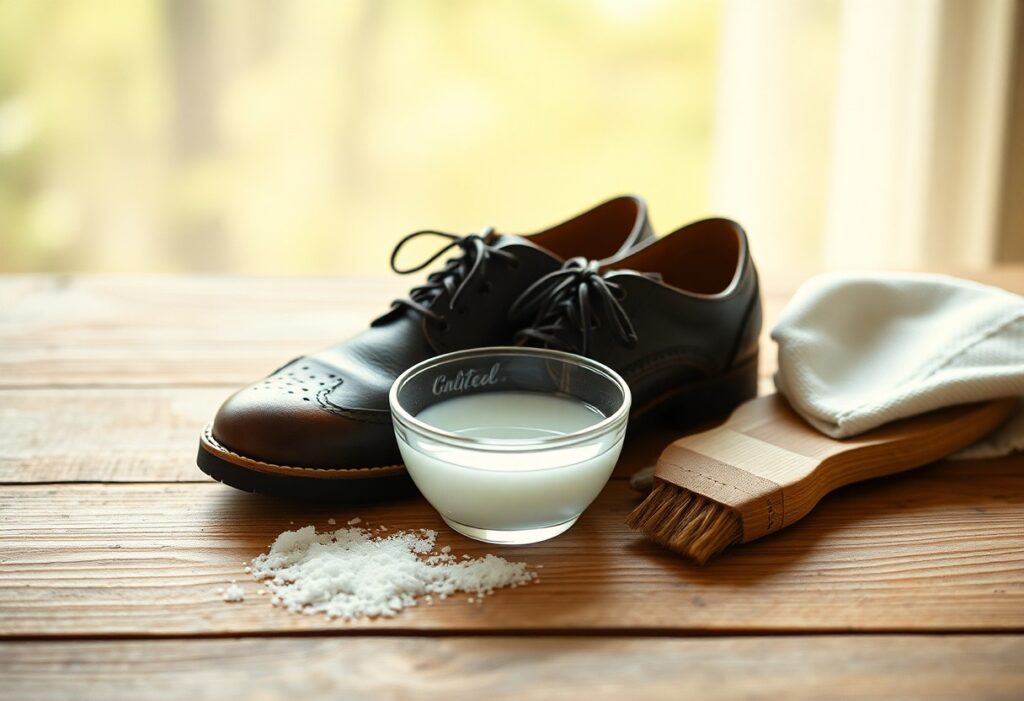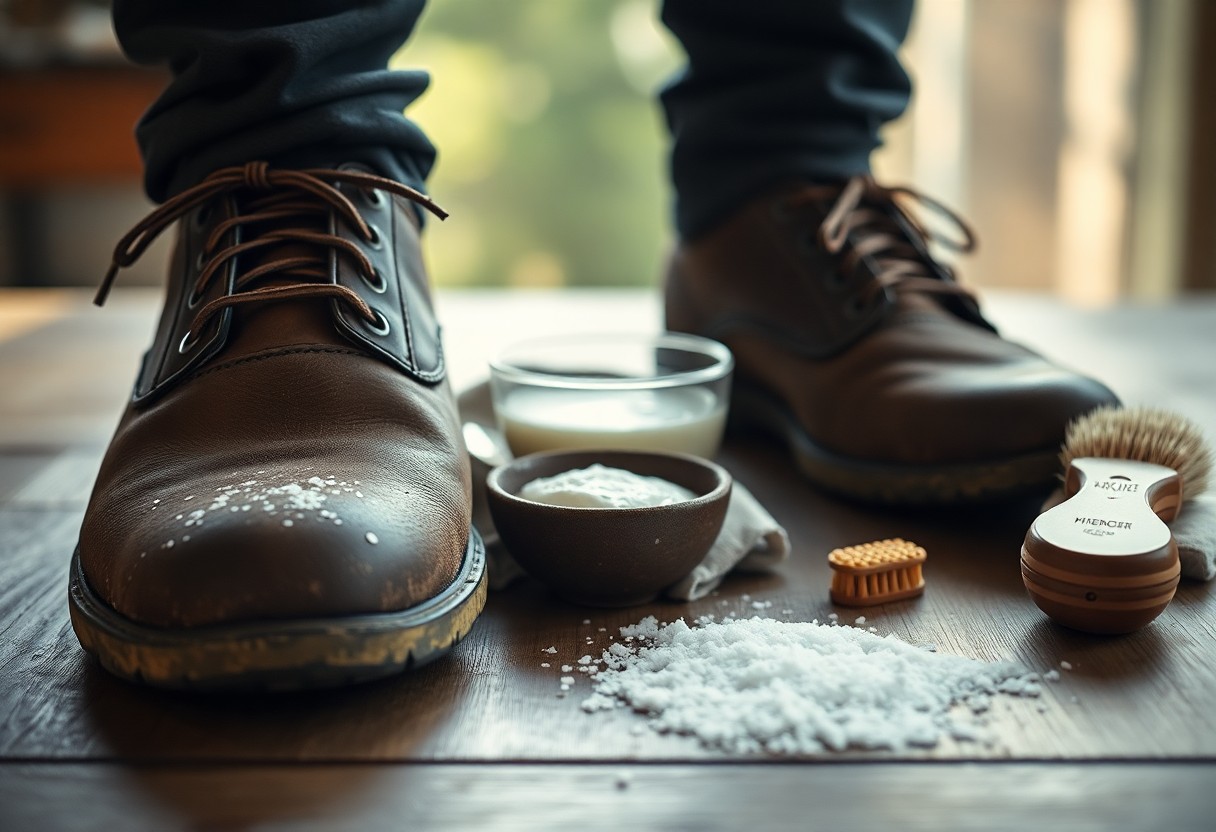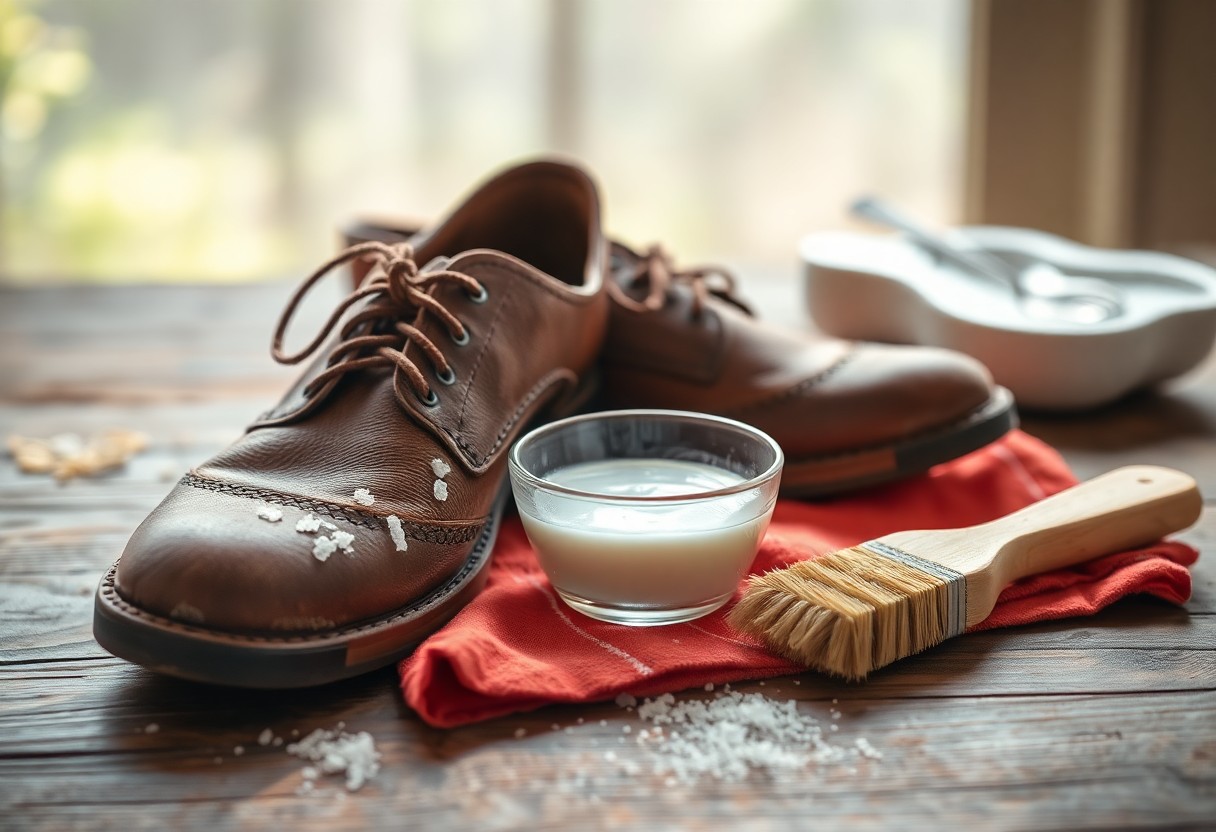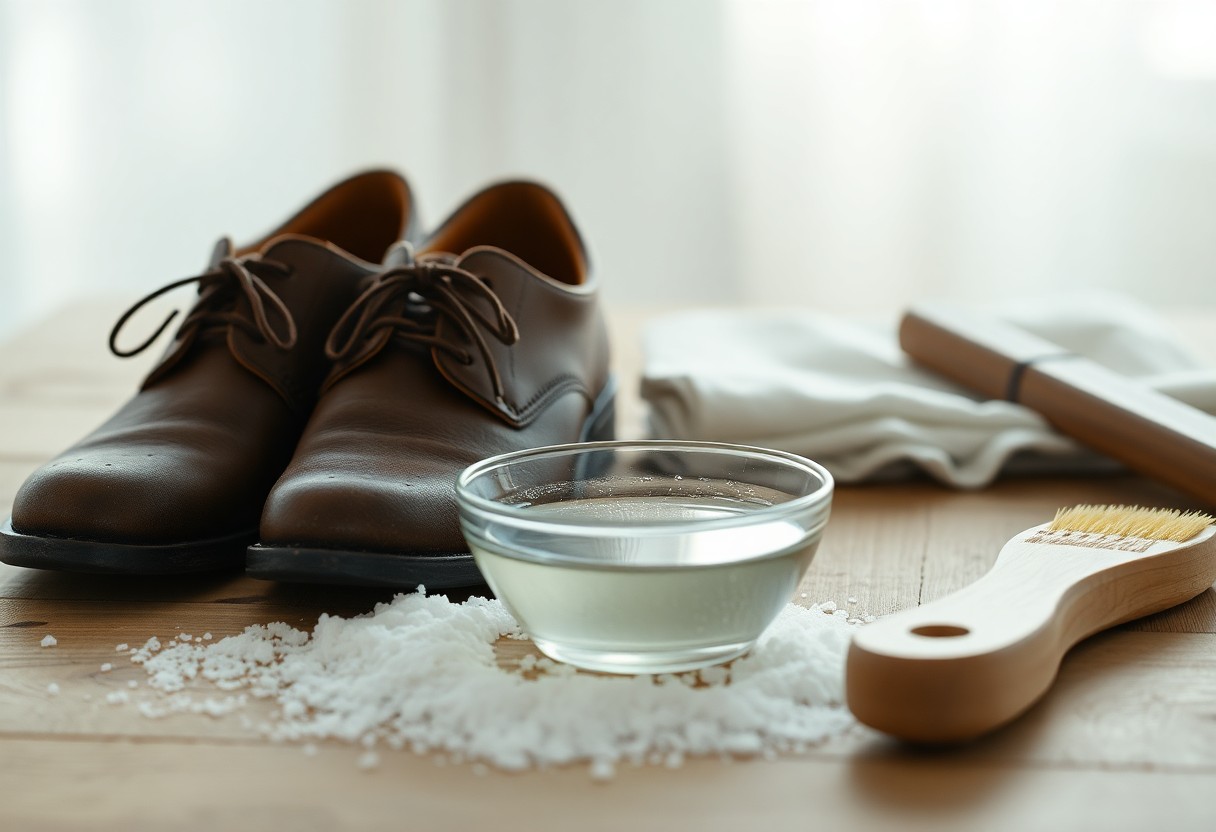
Tips for protecting your shoes during winter can save you from the damaging effects of road salt. If you live in cold regions, your footwear faces constant exposure to corrosive road salt, which can severely damage leather and create unsightly stains. Your best defense starts with prevention through regular cleaning and proper care. You’ll learn practical methods to both prevent and remove salt stains, helping you extend the life of your shoes and maintain their appearance. This guide provides you with proven techniques for daily maintenance and effective stain removal solutions, ensuring your footwear stays protected during harsh winter conditions.
Understanding Salt Stains and Their Impact
A combination of winter weather and road salt creates a destructive force that can severely damage your footwear. When salt-laden snow and slush come into contact with your shoes, they leave behind white residue and permanent stains that can compromise both the appearance and integrity of your footwear.
Types of salt stains on different shoe materials
- Leather shoes show white rings and patches
- Suede material develops crusty white deposits
- Canvas shoes display white powder residue
- Synthetic materials show discolored spots
| Material | Salt Stain Characteristics |
|---|---|
| Leather | White rings and dried patches |
| Suede | Crusty white deposits |
| Canvas | Powdery white residue |
| Synthetic | Discolored spots |
| Nubuck | Rough white patches |
How salt damages leather and other materials
An immediate effect of salt exposure is the dehydration of leather fibers. Salt draws out important moisture from your shoes, leading to cracking, discoloration, and structural weakness in the material.
Stains from road salt can cause permanent damage if left untreated on your shoes. The corrosive nature of salt breaks down the natural oils in leather, weakens fiber bonds, and can lead to irreversible deterioration of your footwear’s material. You should address salt stains within 24 hours to prevent lasting damage.
Prevention Methods and Techniques
While protecting your shoes from salt damage requires proactive steps, you can significantly reduce the risk of stains with proper preventive care. Your shoes need waterproofing treatment before winter season starts, and regular protective sprays application throughout the season. These barriers help repel salt-laden water and prevent direct contact with your shoes’ leather surface.
Pre-treatment solutions and protective measures
To maximize your shoes’ protection against salt damage, start with a leather conditioner application, followed by a quality waterproofing spray. You should reapply these protective layers every 2-3 weeks during winter months. Your shoes will benefit from a wax-based protector for additional defense against harsh elements.
Seasonal maintenance tips and best practices
Techniques for winter shoe care include daily cleaning and proper storage practices.
- Clean shoes immediately after exposure to salt
- Use shoe trees when storing
- Rotate between multiple pairs
- Apply protective spray regularly
Assume that every winter day poses a risk to your footwear.
Maintenance during winter months requires consistent attention to detail and proper timing.
- Check weather forecasts for salt warning days
- Keep cleaning supplies at home and work
- Schedule regular protective treatment days
- Monitor shoe condition weekly
Assume that prevention is more effective than dealing with damage after it occurs.

Step-by-Step Salt Stain Removal
You can effectively remove salt stains from your shoes by following a systematic approach. This process requires attention to detail and the right cleaning supplies to ensure successful stain removal without damaging the leather.
Essential Cleaning Supplies
| Basic Items | Advanced Items |
| Warm water, Clean cloth, Paper towels | Vinegar, Lemon juice, Leather cleaner |
Basic Cleaning Methods for Fresh Stains
Salt stains are most manageable when treated immediately. Use a clean, damp cloth to wipe your shoes from top to bottom, changing the cloth section frequently to avoid spreading the salt.
Advanced Techniques for Stubborn Stains
- Mix equal parts water, vinegar, and lemon juice
- Apply solution with a soft cloth
- Wipe in one direction only
- Avoid oversaturating the leather
Cleaning stubborn salt stains requires a methodical approach. Always test cleaning solutions on a small, hidden area first to ensure they won’t damage your shoes.
Aftercare Steps
| Immediate Care | Long-term Protection |
| Air dry at room temperature | Apply leather conditioner |
Essential Tools and Products
For effective salt stain treatment, you need a well-organized cleaning kit. Your basic arsenal should include clean white cloths, a soft brush, paper towels, and a bowl for mixing solutions. Always keep a dedicated cloth for cleaning at home and work to enable quick response to salt exposure.
Recommended cleaning solutions and materials
The most effective cleaning solutions include a mixture of equal parts water, vinegar, and lemon juice. You can also use commercial products like Saphir salt stain remover. Your cleaning kit should include leather conditioner, shoe cream, and waterproofing spray for post-cleaning care. Avoid using harsh chemicals that could damage your shoes.
Professional vs. DIY cleaning products
With both store-bought and homemade solutions available, you have options for your shoe care routine. Professional products offer specialized formulations and convenience, while DIY solutions using household items can be equally effective and more cost-efficient. Your choice depends on your shoes’ value and cleaning frequency.
Cleaning products vary in their application methods and effectiveness. Professional cleaners typically provide faster results but cost more. DIY solutions like the water-vinegar-lemon mixture need more time and effort but give you control over the ingredients. Your leather shoes’ quality and type should guide your product selection.

Environmental Factors to Consider
Despite varying regional differences, salt exposure and leather damage are influenced by multiple environmental elements. Your shoes face different challenges based on location, climate, and urban infrastructure. Temperature fluctuations, humidity levels, and the type of salt used on roads can affect the severity of staining. Perceiving these factors helps you adapt your protection strategy effectively.
Weather conditions and their impact
Impact of weather varies significantly on your shoe’s exposure to salt damage. When temperatures hover around freezing, wet conditions increase the risk of salt penetration into leather. You’ll notice more severe staining during freeze-thaw cycles, where temperatures fluctuate between day and night. Your shoes are particularly vulnerable during early spring when melting snow mixes with residual road salt.
Storage and maintenance during winter months
During winter season, proper storage conditions become important for your footwear protection. You should keep your shoes in a dry environment with stable temperature, away from direct heat sources. Regular cleaning after each wear prevents salt buildup, while proper ventilation helps avoid moisture accumulation.
Winter shoe care requires your consistent attention to detail. Never store damp shoes in closed spaces, as this can trap moisture and accelerate salt damage. You should maintain a regular cleaning schedule and use shoe trees to preserve shape and absorb excess moisture. Apply protective treatments before the winter season starts to create an effective barrier against salt exposure.
Treatment Methods Comparison
Keep your shoes protected by choosing the right treatment method. Here’s a comparison of available options to help you make an informed decision:
Treatment Methods Overview
| Commercial Solutions | Home Remedies |
|---|---|
| Fast-acting formulas | Cost-effective options |
| Specialized protection | Natural ingredients |
Chemical-based Solutions Pros and Cons
Treatment with chemical-based solutions offers quick results but requires careful handling. Consider these factors:
Chemical Solutions Analysis
| Pros | Cons |
|---|---|
| Quick effectiveness | Higher cost |
| Long-lasting protection | Potential harsh chemicals |
| Professional-grade results | Environmental impact |
| Consistent performance | Storage requirements |
Natural Remedies Advantages and Limitations
Limitations of natural remedies include longer processing time, but they offer safer alternatives for your shoes and the environment.
It’s worth noting that natural solutions like vinegar and lemon juice mixtures provide gentle cleaning action without harmful chemicals. While they may require more frequent application, these methods are budget-friendly and readily available in your home.

Long-term Shoe Care
To ensure your shoes stay protected against salt damage year-round, you need to implement a comprehensive care routine. This includes regular waterproofing treatments, seasonal deep cleaning, and proper storage during off-seasons. After each winter season, your shoes require thorough inspection and restoration to maintain their durability and appearance.
Post-treatment maintenance tips
Even after successfully removing salt stains, your shoes need ongoing care to prevent future damage. Here are vital steps:
- Weekly conditioning of leather surfaces
- Apply protective sprays every month
- Store shoes with cedar shoe trees
- Use protective covers during wet conditions
After treating salt stains, always allow shoes to dry naturally for 24 hours.
Regular care routines and schedules
Maintenance of your shoes should follow a structured schedule. You need to clean your shoes after each wear during winter, apply protective spray every 4-6 weeks, and perform deep conditioning treatments monthly.
It is vital to understand that prevention is better than cure when dealing with salt damage. Your regular care routine should include daily wiping, weekly cleaning, and monthly treatments. This systematic approach helps extend your shoes’ lifespan and maintains their appearance through harsh winter conditions.
To wrap up
With this in mind, your best defense against salt damage combines prevention and quick action. You can protect your shoes by wiping them down immediately after exposure to salt, using proper techniques and the right cleaning solutions. If you spot salt stains, act fast with a vinegar-water-lemon solution or specialized cleaners. After cleaning, always condition your leather to restore moisture. These simple steps will help you maintain your shoes’ appearance and extend their life through winter seasons.
FAQ
How can I prevent salt stains from forming on my leather shoes during winter?
Clean your shoes immediately after exposure to salt using a damp cloth with warm water. Wipe in one direction from top to bottom, changing the cloth area frequently. Repeat this process 2-3 times, paying extra attention to areas near the sole. Apply a leather protector before winter starts to create a barrier against salt damage.
What is the best homemade solution to remove existing salt stains from leather shoes?
Mix equal parts water, vinegar, and lemon juice to create an effective salt-dissolving solution. Apply this mixture with a clean cloth, wiping from top to bottom. Clean the cloth frequently during the process. After removing the salt, wipe the shoes with plain water using a fresh cloth, then let them dry completely before applying leather conditioner.
How do I know if I have successfully removed all the salt from my shoes?
Look for white residue on the leather surface – if none is visible, you have likely removed all the salt. Note that dark stains may remain on the leather even after salt removal. These marks show where the salt damaged the leather, but they do not indicate active salt presence. Always condition the leather after cleaning to restore moisture.








I can totally relate to the struggle of keeping shoes in good shape during winter. I remember the first time I made the mistake of wearing my favorite leather boots in slushy weather—what a mess! I’ve found that a good waterproof spray can be a lifesaver before the snow hits, but I still end up doing some cleaning mid-season to keep them looking decent. Have you tried any specific products or techniques for treatment? I’m curious if there are any new tips or tricks that have emerged since last winter. Plus, it’s interesting how our footwear maintenance can really reflect how we engage with our local environment, especially in places where winter feels relentless! Would love to hear more methods anyone else has found effective!
I totally get what you mean about the struggle with winter shoes. That first time ruining leather boots in slush is a rite of passage for many! Your tip about the waterproof spray is spot on. I’ve used it too, and it really makes a difference, especially with those unexpected wet patches.
I can relate to that first experience of ruining leather boots; it’s almost a rite of passage we all seem to share. I remember my first pair of nice boots, and it felt like a heartbreak when I realized I couldn’t protect them from the winter slush. It’s funny how footwear can hold so many stories about our experiences with the elements.
It’s interesting how a pair of leather boots can turn into a piece of our personal history, isn’t it? There’s something about investing in a nice pair that makes you feel like you’re stepping into a new chapter, but then the reality of the elements hits hard. That heartbreak you mentioned resonates so deeply. It’s like we share this unspoken bond over the little tragedies of life—like fighting against winter slush and losing, or struggling with a stubborn stain that just won’t budge.
It really is fascinating how something as seemingly simple as a pair of boots can carry so many stories and memories. Investing in a quality pair does feel like a rite of passage, doesn’t it? It marks the start of new adventures, but as you said, reality often interjects with the elements. I can’t help but think of how those little tragedies reflect on our resilience.
It’s true, a good pair of boots can feel like a passport to new experiences. Investing in them really does feel like taking a step into unknown territory—literally and metaphorically. And those little dramas we face in the great outdoors? They really do test our mettle. I think about all the times I’ve been caught in the rain, mud caked on my boots, or trekking through challenging terrain. Each scuff tells a new story, and when you look back, those little mishaps often turn into fond memories. They remind us that it’s not just about the destination; it’s about how we handle the bumps along the way. Plus, there’s something about the wear on a good pair of boots that reflects our journey through life, right? Each scuff, a badge of honor. What’s your favorite adventure that left its mark on your favorite pair?
You really hit the nail on the head with that perspective—those scuffs and scratches are like a visual diary of our adventures. I remember a hike I did in the Pacific Northwest a couple of years back. We started off in this lush, green forest, and as we made our way up the mountain, the weather took a turn. We ended up navigating through a heavy downpour that turned the trails into slippery mudslides. My boots were completely coated by the end of it, but the feeling of triumph when we finally reached the summit was worth every squelchy step.
Speaking of stepping into new experiences, have you ever considered how the right footwear can elevate your adventures?
‘Toe Ring Barefoot Sandals: Step up your style’
https://myshoesfinder.com/xero-sandals/toe-ring-barefoot-sandals/.
I completely resonate with that idea of boots being more than just footwear—they’re like companions on our adventures, each telling a story of where we’ve been. I remember one particular hike that tested my boots and my resolve. It was one of those unexpected weekends where the weather turned sour. I was meandering along a familiar trail, but this time, the rain transformed it into a muddy challenge.
It’s interesting to think about how much a pair of boots can symbolize. For me, investing in a quality pair has always felt like a blend of practicality and symbolism. On one hand, they’re meant to endure the elements, which can be seen as a reflection of what we face in life—those little tragedies you mentioned often remind us of our own resilience.
It’s so true how a pair of leather boots can embody so much more than just footwear. They often carry the imprints of our lives, don’t they? I remember buying my first pair of quality boots, feeling like I was making a tangible commitment to stepping out into the world with purpose. It’s fascinating how these items, once pristine, transition into vessels of memories, each scratch and mark telling a story of its own.
Speaking of stepping into new chapters, I recently came across this piece on toe ring barefoot sandals that explores how the right footwear can elevate our style while keeping comfort in mind, even as we tackle those everyday challenges.
‘Toe Ring Barefoot Sandals: Step up your style’
https://myshoesfinder.com/xero-sandals/toe-ring-barefoot-sandals/.
You’ve captured something really special there. It’s interesting how leather boots evolve into more than mere accessories; they become witnesses to our journeys, holding moments that resonate with our personal stories. Each mark really does contribute to a unique narrative, reflecting not just the places we’ve been but the experiences we’ve gathered along the way.
It’s interesting how we tend to attach memories and emotions to our footwear, isn’t it? Those first experiences really do shape our perspective on the journey we take with our things. I remember the crunch of snow underfoot and the sinking feeling when I first noticed the scuff on my boots after a day out. It’s a reminder of our own vulnerability against the elements and how sometimes, despite our best efforts, things don’t stay pristine.
I completely agree with you about the memories we tie to our footwear. It’s fascinating how something so seemingly mundane can hold such profound significance. I vividly remember my first pair of hiking boots—a sturdy pair that accompanied me on my first solo backpacking trip. Each scuff and mark they collected tells a story of triumph and challenge, from trekking through muddy trails to conquering my first mountain summit.
I find it fascinating how our belongings can embody such rich narratives. Footwear seems particularly symbolic; each scuff or mark tells a story. That crunch of snow underfoot brings back memories for me too. On a snowy day, my first pair of winter boots was a mix of functional and sentimental, and as I stomped through the drifts, every step felt like an adventure.
It’s true how our shoes carry memories; if you’re looking to keep those sentimental journeys going for longer, I found some helpful tips that might make a difference.
‘Tips for extending the life of your shoes’
https://myshoesfinder.com/tips-to-prolong-your-shoes-lifespan/.
I can definitely relate to that struggle with winter shoes. It’s almost like you have to choose between style and staying dry. I remember my first pair of leather boots too—they looked so good until they met a muddy sidewalk for the first time. It’s funny how those little experiences can teach you so much about the importance of taking care of your gear.
I think it’s interesting how winter shoes can really shape our entire cold-weather experience. The struggle with finding that balance between style and practicality can feel daunting. I remember my first pair of leather boots; I cherished them until one day they encountered a surprise slush puddle. That was a harsh lesson in winter readiness.
It’s so true that winter footwear can significantly impact how we experience the season. There’s definitely an art to finding that sweet spot between style and practicality. I remember my first pair of winter boots too; they were gorgeous but didn’t have any waterproofing to speak of. I learned after a similar incident—the regret of soggy socks is a lesson no one forgets easily.
I totally get what you mean about the struggle with winter footwear. That first snow always catches me off guard, and I’ve made similar mistakes with my favorite boots! Last winter, I invested in a waterproofing product from a local brand that’s been getting good reviews. It’s a spray that you apply heavily before the snow starts, and it claims to create a pretty solid barrier against slush and salt. I’m hopeful that it’ll help keep my shoes in better shape this year.
I hear you about that first snow—it always catches me off guard too. It’s like you just get used to the fall leaves and suddenly it’s a winter wonderland. I’ve had my share of boot mishaps as well, especially with all the slush and salt wreaking havoc on anything I wear.
I hear you on that winter footwear struggle—finding the right fit can be a real challenge, but I recently came across some handy tips for finding the perfect shoes, especially for those of us with wider feet.
‘Finding the perfect shoes for wide feet tips and recommendations’
https://myshoesfinder.com/tips-for-finding-perfect-shoes-for-wide-feet/.
I totally get that feeling of being caught off guard by the first snowfall. It transforms everything so quickly, and suddenly you have to adjust to new routines—mixing in the winter gear is always a challenge. I remember the first time I stepped out into the snow with boots that were more fashion than function. Let’s just say I learned my lesson the hard way.
You’ve hit the nail on the head with that feeling of being caught off guard. It’s like Mother Nature throws a surprise party, and we show up in our summer shorts, completely unprepared. I can still picture that first snow of the season; the world outside goes from drab to dazzling, but my wardrobe remains stuck in the past.
It’s interesting how that first snowfall can really catch us off guard, isn’t it? The way it blankets everything can feel almost magical at first, but then reality sets in—like the reality of winter gear. Your experience with the fashion-over-function boots resonates with many of us; it’s a classic pitfall. It’s funny how we can be so focused on the visual aspect that we forget practicality, especially when navigating slushy streets.
It’s so relatable to feel blindsided by that first snowfall. Those surprise moments can really make us rethink our footwear choices. It sounds like you found a solid solution with that waterproofing spray. I’ve heard good things about similar products too. It’s impressive how much a little prep can change things up when you’re up against slush and salt.
I can definitely relate to that experience. It’s such a bummer when you have to deal with scuffed or water-damaged shoes, especially when you love them so much. I’ve had a few pairs suffer the same fate, where slush is basically a shoe’s worst nightmare. Using that waterproof spray has helped me a lot, too. I tend to do a couple of layers, just to be safe, and some brands even say it can provide some UV protection, which is an added bonus for the summer months.
I completely get where you’re coming from. It’s like our favorite shoes can sometimes turn against us, especially in those messy conditions. The slush really is a sneaky culprit, creeping up when we least expect it. Your approach with the waterproof spray sounds smart; layering up definitely gives that extra peace of mind.
It’s so true—the way our favorite shoes can betray us really highlights how unpredictable the weather can be. It’s like walking through a winter wonderland one minute and facing a mini swamp the next. I’ve had my fair share of ruined sneakers after that sneaky slush gets in.
I can relate to your experience with slush—it feels like it has a personal vendetta against our favorite shoes. It’s almost like we can predict the weather, and the moment we step out in those fresh kicks, a storm rolls in. Using that waterproof spray has been a game changer for me as well; I’ve found that applying several layers not only helps with protection but also gives me peace of mind when I’m out on rainy days.
You’re definitely not alone in that struggle with winter footwear. Slushy weather can really take a toll on shoes, especially when it comes to leather. I had a similar experience my first winter out with new leather boots, and now I try to be much more proactive with them.
This post brings up an issue that many of us often overlook until it’s too late. Living in a colder climate, I’ve encountered firsthand the challenges that road salt presents to our footwear. It’s intriguing how something as mundane as winter weather can have such a profound impact on the longevity of our shoes.
You bring up a really important point, and it’s something many of us can relate to, especially during those long winter months. When you live in a cold climate, those seemingly innocent little piles of road salt can wreak havoc on our favorite shoes without us even realizing it at first. It’s one of those things that’s easy to overlook until you notice how worn out your footwear seems, or worse, find yourself replacing them more often than you’d like.
You’re right, it’s one of those issues that seems minor until it starts affecting our daily lives. Living in a colder climate often means we have to deal with that constant battle between staying warm and keeping our gear in good shape, and road salt can be a real nemesis for our footwear. It’s not just the initial damage, but the fact that it can lead to ongoing problems if not addressed.
You’ve captured a key point there. The wear and tear from road salt can really sneak up on us, especially in colder climates where we rely on our shoes for warmth and safety. It’s easy to forget how harsh those winter conditions can be on our footwear until we start noticing cracks or discoloration.
It’s true—road salt can sneak up on you, right? One day your shoes look great, and the next, they’re battling scuffs and stains that seem impossible to remove. Living in a colder climate, I’ve had my fair share of ruined footwear as well. It’s funny how something so essential for road safety can also wreak havoc on our favorite pairs of shoes.
Your insights on protecting shoes during winter resonate deeply with me. Living in a region where winters can be brutal, I’ve faced the dilemma of maintaining my footwear while trying to brave the cold and slush. I’ve learned that regular maintenance is indeed essential, especially the importance of waterproofing treatments and the right materials.
It’s great to hear your thoughts on this! Winter can really be tough on shoes. I’ve found that choosing the right materials makes a huge difference. For instance, leather is fantastic for style, but it definitely needs a good waterproof treatment to hold up in slushy conditions. And I totally agree on the regular maintenance—just a quick wipe down after being outside can really extend the life of your shoes.
I really appreciate the insights you’ve shared about protecting footwear during the winter months. Living in a cold region myself, I can definitely relate to the struggle of keeping shoes looking pristine amidst the brutal combo of snow and road salt. It’s disheartening to invest in a good pair of leather boots only to see them succumb to those unsightly stains.
I truly appreciate this discussion about the challenges posed by winter and the relentless road salt on our footwear. Living in a colder region myself, I can attest to the damage that salt causes—not just to shoes but to our wallets as well, when we have to repeatedly replace them. Your emphasis on prevention through regular cleaning and care resonated with me, as I’ve often found that my shoes fare much better with some proactive measures rather than waiting until the damage is done.
I completely resonate with your experience regarding the winter challenges and how road salt can be a real nuisance for footwear. It feels like a never-ending cycle of maintenance just to keep our shoes looking decent. I’ve started to view shoe care almost like a preventative health measure; just as we take care of our bodies to ward off illness, a little attention to our footwear can save us from the financial drain of constant replacements.
It’s interesting to see how something as seemingly mundane as road salt can have such a profound impact on our footwear. I’ve often found myself neglecting my shoes during winter, thinking they could withstand the elements without any special care. However, the reality has been harsh—a couple of seasons with little maintenance have left my favorite pair of leather boots looking worn and stained from salt damage.
You’re spot on about how road salt can sneakily wreak havoc on our shoes. It’s easy to overlook the little things when we’re just trying to get through the winter months. I’ve been there too—those leather boots that once looked pristine can end up looking like they’ve been through a war zone after a couple of winters without care.
You bring up a great point about how road salt can sneak up on us and wreak havoc on our shoes. It’s easy to underestimate just how harsh winter conditions can be, especially when we’re rushing out the door or thinking that our footwear is tougher than it really is. Leather boots, while sturdy, can really suffer if we don’t give them a little TLC during the colder months.
It’s fascinating how something as simple as road salt can wreak havoc on our favorite shoes during the winter. I’ve definitely learned the hard way about the importance of preventive care! One technique I’ve found really helpful is applying a waterproof spray before the first snowfall; it creates an extra barrier that helps repel salt and moisture.
I found your insights on protecting shoes during winter incredibly relevant, especially since I’ve seen friends make the mistake of neglecting their footwear during these months. It’s so easy to forget that our shoes endure weathering just like we do, and with winter’s onslaught of snow, ice, and road salt, they really need our attention!